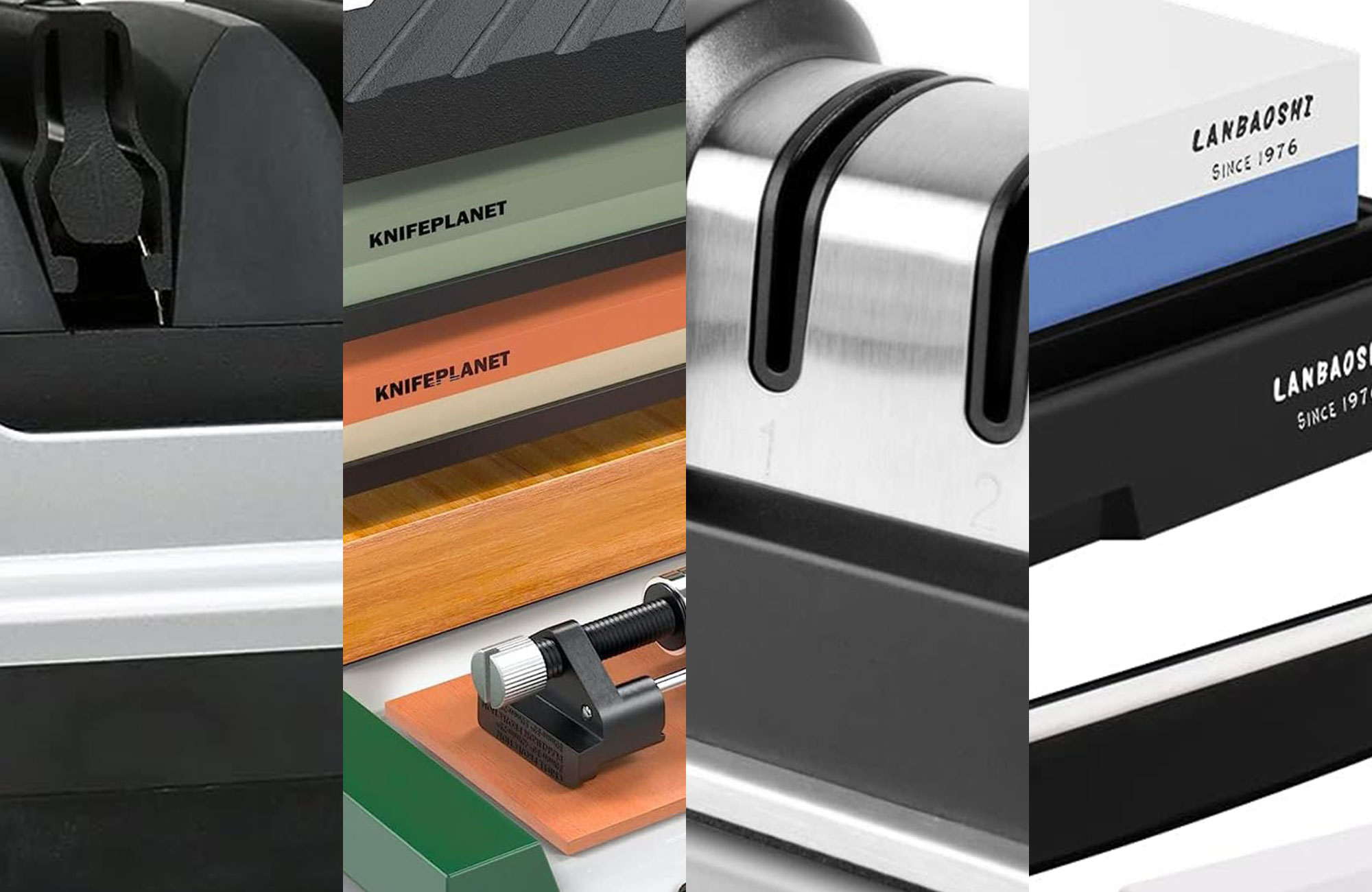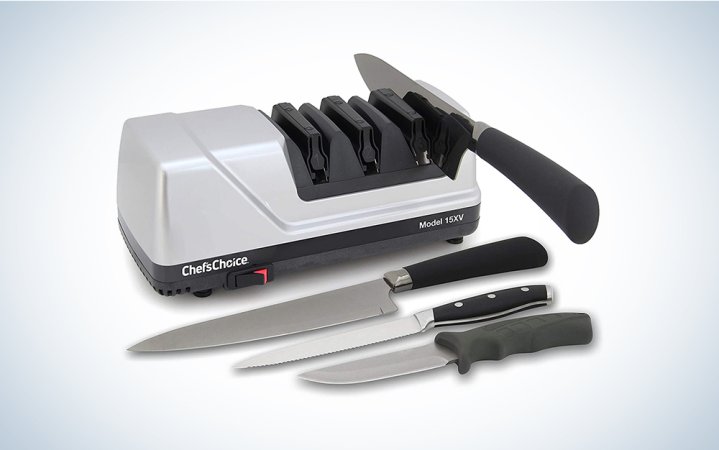We may earn revenue from the products available on this page and participate in affiliate programs. Learn more ›

If you have a kitchen knife, you need a knife sharpener to maintain it. It might sound crazy, but a dull knife is a dangerous knife. When a knife is dull, it’s more likely to slip off whatever you’re attempting to cut, and when it slips, it can hit a finger. On the other hand, a super-sharp knife will stay where you want it to—away from your hands—and make your life far easier in the kitchen. But there are so many different kinds of home sharpeners. There are electric sharpeners, two-stage hand sharpeners, and whetstones. It can be difficult to know which one is right for you, but a lot depends on what kind of knife you have and how much you care about keeping it around. Remember that when you’re sharpening a knife, you’re removing metal. The more you remove, the shorter your knife’s lifespan will be. The goal is to remove the bare minimum of metal, which can be tricky at first. Used correctly, however, the best knife sharpeners will maximize your knife’s lifespan and effectiveness.
- Best overall: Chef’sChoice Trizor XV
- Best whetstone: Premium Knife Sharpening Stone Set
- Best honing steel: 10 Inches Honing Steel Knife Sharpening Steel Sharpening Rod
- Best manual: PriorityChef Knife Sharpener for Straight and Serrated Knives
- Best budget: Whetstone Knife Sharpening Stone Set
How we chose the best knife sharpeners
We prioritized knife sharpeners that kept the knife’s edge in the proper position. We only have one manual sharpener on the list because you’re better off with a whetstone or honing steel. However, these are perfect for sharpening cheap paring knives or scissors. We also looked at reviews and recommendations and conducted heavy research to narrow down our picks.
The best knife sharpeners: Reviews & Recommendations
From a chef’s knife to the cheapest of blades, one of our choices should keep every knife in your arsenal sharper than the day you got it.
Best overall: Chef’sChoice Trizor XV
Electric Power
Pros
- Keeps your knife in the right sharpening position
- Faster than manual options
- Longlasting
Cons
- Not the best for expensive knives
Specs
- Number of stages: Three
- Dimensions: 10 x 4.25 x 4.25 inches
- Grits: N/A
Electric knife sharpeners aren’t cheap, but if you’re unsure of your skill with a trickier whetstone sharpener, the Chef’sChoice Trizor XV is an excellent option. It’ll keep your knife in exactly the right position, so you don’t have to worry about creating a weird angle on the knife edge. It’s also far faster than manual options, delivering a perfectly sharp knife in just a few minutes. If you want to invest in a great knife sharpener but don’t want anything too difficult, this is the product for you.
Best whetstone: KnifePlanet Premium Whetstone Set
No Accidents Here
Pros
- Lots of included goodies
- Can use with just water
- Great for beginners
Cons
- Some reviews note some chips in stones upon arrival
Specs
- Number of stages: Four
- Dimensions: 7.09 x 2.35 x 1.18 inches
- Grits: 400/1000; 3000/8000
Whetstones are an older style of sharpener; they’re slower but also much less expensive, gentler on blades, and easy to use after a bit of practice. Whetstones are essentially blocks of sandpaper in different textures. You hold your blade at the desired angle, drip some water on the stone, and rub the blade back and forth to wear it into a sharp, honed edge. This particular knife sharpening stone set includes everything you need: different grits of whetstone sharpener, a rubber non-slip base, and a bamboo holder. The Sharp Pebble Extra Large Sharpening Stone Set with a non-slip bamboo base is a slightly more expensive runner-up.
Best honing steel: Utopia Kitchen Honing Steel
Efficient Tool
Pros
- Lifetime warranty
- Ergonomic handle
- Resistant to heat and cold
Cons
- Need to make sure you use it correctly
Specs
- Number of stages: N/A
- Dimensions: 10 inches
- Grits: N/A
A honing steel is a pretty simple tool, and you should never need to spend too much on one (especially because you’ll have to replace it every year because the grooves will wear out). This particular tool is inexpensive, available in two sizes, and has a nice ergonomic handle. If you want to invest a little more cash in a sharpening tool, we recommend the thoughtfully designed Saveur Selects Carbon Sharpening Steel. It uses industrial-grade diamonds for the sharpening surface and carries a lifetime warranty against defects.
Best manual: PriorityChef Knife Sharpener for Straight and Serrated Knives
Great Price
Pros
- Easy to use
- Non-slip base
- Can also sharpen scissors and serrated knives
Cons
- Design hard to keep blade at a proper 90 degrees
Specs
- Number of stages: Two
- Dimensions: 7.5 x 2.5 x 2.5 inches
- Grits: N/A
Pull-through sharpeners aren’t ideal for expensive knives and should never be used for Japanese knives of any sort. But they are great for a quick re-sharpening of little blades and scissors. This Priority knife sharpener has a two-stage process, which minimizes the amount of metal you’re removing in each stage. You can also use it to sharpen scissors and serrated knives.
Best budget: KnifePlanet Dual-Grit Whetstone
Budget Pick
Pros
- Angle guide included
- No oil needed
- Easy to clean
Cons
- Can leave noticeable large abrasion marks
Specs
- Number of stages: Two
- Dimensions: 7.25 x 2.25 x 1.2 inches
- Grits: 1000/6000
You might notice some figures on a whetstone, like 1000/6000. Those refer to the “grit” or little particles that make the surface rough. The higher the number, the more grit in the same amount of space (meaning, the higher the number, the smoother the stone). This knife sharpening stone’s clever design allows you to flip the whetstone sharpener over to go from rough to fine.
What to consider when buying the best knife sharpeners
The best knife sharpeners come in various configurations and with many different features. The options with bells and whistles aren’t necessarily what the professionals would recommend, but they can be the easiest to use. Here’s your guide to finding the best knife sharpener.
Are knife sharpeners bad for my knives?
Potentially, but only if you use the wrong sharpener—or the right sharpener in the wrong way. When you sharpen a knife, you’re shaving down the metal of your blade to create a new edge. This is a very precise process. When using a knife sharpener, it’s all too easy to create nicks and divots in a blade, or to create an edge that’s dull or uneven.
Before using a knife sharpener, read the instruction manual cover to cover. Don’t assume you know how the sharpener works, and don’t just jump in: That’s the quickest way to ruin the most important tool in your kitchen. Follow the instructions as carefully as possible. And never, ever apply too much pressure: The weight of the knife should do the work here, and it’s much better to go too easy than too heavy.
What about honing steels?
Honing steels are an essential part of keeping your blades sharp—but they aren’t in themselves sharpeners. A sharpener erodes part of the metal on your blade to create a new edge; a honing steel does something different. Think of a blade as a toothbrush, with each individual bristle being a little bit of the edge. A blade may look like one piece, but each of those individual bristles can get out of alignment, creating a duller feel, even if the actual blade doesn’t need sharpening. A honing steel is a length of metal that aligns all of those bristles when you run it back and forth on the blade. You should be honing your knife before each use—it only takes a few seconds and will make a huge difference.
What kind of knife sharpeners should I avoid?
In general, you’ll want to avoid the pull-through-style manual knife sharpener. This type has multiple V-shaped openings through which you stick your blade and pull it through. Most professionals do not recommend them, because they eat away a lot of the blade and can create uneven, almost serrated edges. That said, they’re very quick and inexpensive, so it wouldn’t be crazy to have one around for stuff you don’t care so much about: pairs of scissors, little paring knives, that kind of thing.
I’m on a budget. Do I have to live with dull knives?
Definitely not! Your best option here is a whetstone sharpener. Even the best whetstones aren’t very expensive, but you can opt for a double-sided one for under $25. The trade-off is the same as with any other whetstone: It just takes a little practice to perfect the motion you need to use them. But the rewards are also the same. You can create a perfect, professional knife edge on a Western-style or Japanese-style knife, a pair of scissors, or any other blade in your home.
FAQs
The best knife sharpener for beginners depends on one major question: Do you want to put in the time and effort to learn to use a whetstone? If not, go for an electric sharpener; it’s the easiest, most foolproof way to sharpen your blades.
The best sharpener for a chef’s knife is either an electric knife sharpener or a whetstone for a chef’s knife. A chef’s knife is a Western-style knife; it’s sharpened on both sides of the blade’s edge and is more curved than, say, a Japanese-style santoku. When using a whetstone, you’ll have to flip the blade over to sharpen both sides, but it’ll work perfectly well.
In general, knife sharpeners last a long time. Electric ones often have diamond-tipped metal pieces, which won’t wear out. Whetstones also won’t wear out, but they do require a little bit of upkeep. Refer to your whetstone’s instruction manual, but it’ll probably involve soaking in water now and then.
Final thoughts on the best knife sharpeners
- Best overall: Chef’sChoice Trizor XV
- Best whetstone: Premium Knife Sharpening Stone Set
- Best honing steel: 10 Inches Honing Steel Knife Sharpening Steel Sharpening Rod
- Best manual: PriorityChef Knife Sharpener for Straight and Serrated Knives
- Best budget: Whetstone Knife Sharpening Stone Set
Sharpening your knives at home can be a soothing, meditative experience with a whetstone or an ultra-efficient job with an electric sharpener. What’s most important is keeping your knives sharp—both for ease of use and for your safety.








